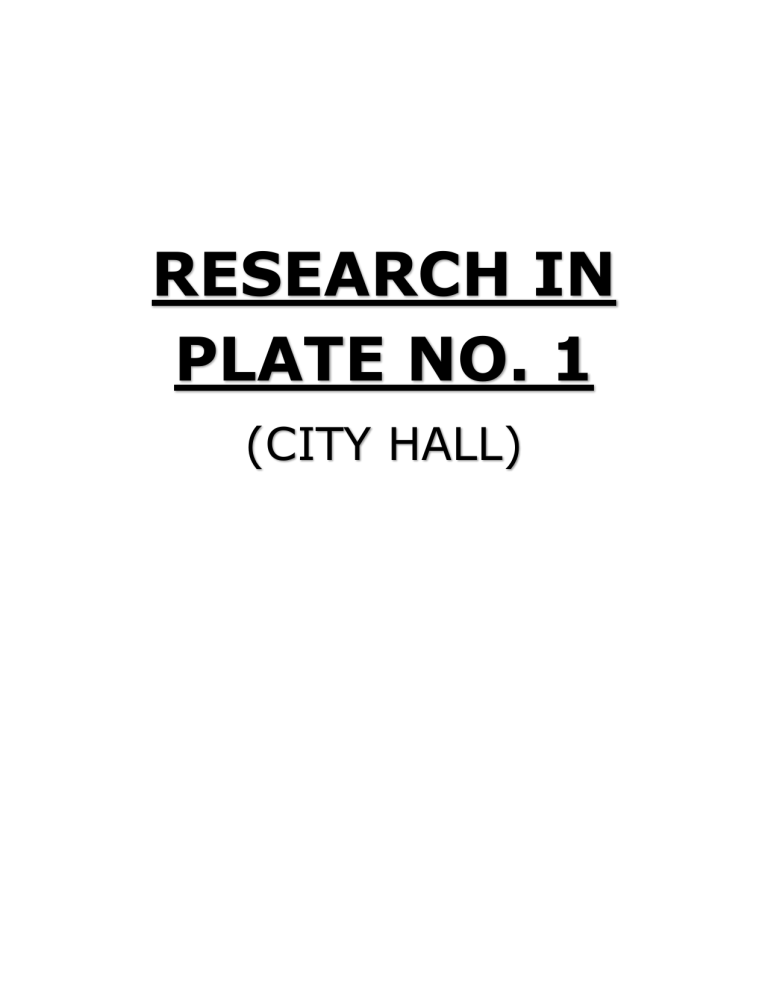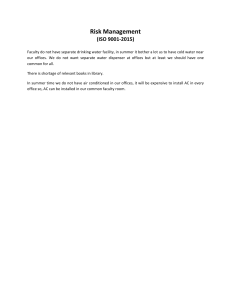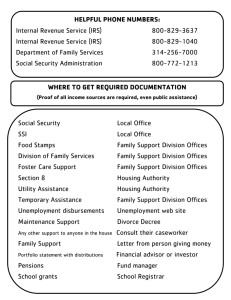
RESEARCH IN PLATE NO. 1 (CITY HALL) CITY HALL Steps to be taken in planning and constructing a City Hall are: 1. 2. 3. 4. 5. 6. Determining need Determining space requirements Selecting an Architect Acquiring a site Approving layout, design, and architectural features Developing Financial Plan SPACES LOBBY CITY CLERK - City Clerk Receptionist - Clerical - Accounting clerical - City auditor-clerk - Chief deputy auditor-clerk - Vault CITY TREASURER - Public Service - Clerical - Vault - Treasurer’s office BUILDING DEPARTMENT - Chief Building inspector - Public service - Clerical - Asst. Supt. Of building - Building inspector - Conference room - Plan check Engineering permit and inspection section Engineering budget and cost accounting section Traffic engineer asst. street supt. Engineering design section Asst. city engineer Secretary City engineer Storage Civil defense Council chamber Councilmen offices Conference room LEGAL DEPARTMENT - Clerical - File room - Attorney’s office - Secretary - Reception room LIBRARY EMPLOYEE LOUNGE PERSONNEL DEPARTMENT - Personnel office - Personnel director FIRST AID ROOM MAYOR’S OFFICE CITY MANAGER - Asst. city manager - City manager - Secretary receptionist - Storage POLICE DEPARTMENT FIRE DEPARTMENT COURTROOM OFFICE FOR THE CHIEF ADMINISTRATOR JANITOR ROOM UTILITY STORAGE RESTROOMS LAYOUT, DESIGN, AND CONSTRUCTION FEATURES General Building Layout Building arrangement is the next step in planning a city hall. It is helpful as a starting point to use the following checklist of departments, offices, special-purpose rooms, and service areas in analyzing interior building requirements: 1. Departments requiring constant contact with the general public and the collection or payment of money-for example, the finance department and tax collector 2. Departments requiring contact with special classes of the public-for example, city owned utilities, building permits, personnel, city planning, and city clerk 3. Other departments including public works, recreation, police, fire, etc. 4. City council chamber and office space for use by the mayor and councilmen 5. Offices for the chief administrator 6. Courtrooms 7. Storage vaults and record rooms 8. Locker rooms, rest rooms, janitor closets, public telephones, and space for heating, ventilating, plumbing, and electrical equipment 9. "Circulating areas" for lobbies, corridors, elevators, and stairways The relationship of one room or functional area to another is important. No room exists by itself, and many of the problems of living in a building arise from the neglect of this fact. Departments related in function should be located near one another and consecutive operations planned in production-line style. Excessive lobbies and hall space add to the cost of construction without adding usable space. The height of the building will depend upon the amount of ground available and the amount of office space needed. Land generally is cheaper than additional height. Taller buildings are more difficult to maintain and require more planning of the interior to get related functions on adjacent floors. Also, any city building of more than two floors should have an elevator, especially if the public has any great use of the top floor. Provision for a full basement housing general offices is not often made in now city office buildings. Most professional organizations advise against locating general offices in the basement. The basement can be used for storage and service activities such as duplicating, receiving and shipping rooms, heating and air-conditioning equipment, and central switchboard. Departmental Layout Departmental layout will depend on the activities carried on by the department and the tools or special equipment used. For example, a finance department layout may require an open area for accounting clerks and collectors with one or two private offices, a machine room, and a vault. The public works department, on the other hand, may require private offices for the director, the engineer, and individual inspectors, a drafting room, a vault, a plan or map room, and conference rooms. The first step in departments [ layout is to survey the work done by the department. Work flow should be especially studied. A complete list should be made of all employees and equipment to occupy the space. The possibility of future expansion should be anticipated and provision made for additional personnel. Provision also should be-made for peak rather than average workloads. Flow of work should, as nearly as practicable, be in a straight line. Normally, work should come to the employees rather than their going to the work. Minor activities can be grouped around areas of major activity. Private Offices A major factor in the determination of space needs is the question of who should get private offices and under what circumstances. More space is required for private offices; space utilization is restricted through segregation of areas for private offices; and considerable expense is involved in rearranging and re-erecting partitions. Ventilation, lighting, and heating problems are complicated by a number of small offices; supervision and coordination of work, flow of work, and communications are made more difficult. An open, wall-arranged office has a more orderly and businesslike appearance then a series of small offices. Certain conditions justify private offices. First, transactions of a confidential nature require private facilities. General conference rooms, however, where confidential meetings may be held as occasion demands, may reduce the need for private offices. Second, privacy is often desirable not so much because of the confidential nature of the work, but because of the number of persons interviewed or because the work is of an independent nature which requires quieter and privacy than the open office will allow. There in little agreement as to who should have private offices except for the chief administrative officer and department heads. Chief Administrator's Office The location of the chief administrator's office is important to good public relations. It should be located so as to give the impression of being easily reached and open to any caller, but it should not be too prominent. The second floor ordinarily is a good location since some effort must be expended to visit it, and the casual or merely curious individual is less likely to intrude. A first-floor location, however, can be just as good if callers are properly screened by a secretary or receptionist, it has the additional advantage of being close to the offices most frequented by the public. Of interest to council-manager cities is the fact that the mayor has an office in the majority of cases located very close to the city manager's office. See the second-floor plan of the Alhambra, California, city hall for a typical executive layout The administrator's office should be large enough for meetings of department heads unless a conference room adjoins his office. A conference table that will accommodate up to 12 people is desirable. Space should be provided adjacent to the administrator's office for a secretary and one or more assistants, depending upon the size of the city. The secretary's office would also serve as a reception room for people who call on the administrator. Council Members The council meeting room should be carefully planned if full use is to be made of it. Location of the council chamber is important because of the public nature of the business transacted there. Most of the cities with multistoried buildings have located the council room on the first or second floor. The offices located near or around the council chamber are usually those of the city clerk, city attorney, and city manager. Small meeting rooms and an office for the mayor and councilmen may be located nearby. In most cities surveyed, councilmen sit at separate desks or at a semicircular table, the open end of which faces the citizens. In only a few cities do the councilmen have their backs to the public. The mayor usually sits in the center flanked by the manager, clerk, and attorney. The council table often is put on a dais 18 in. or 2 ft above the main floor. It is well to plan the council chamber so that it also can be used for other purposes. In many cities it is used as a general courtroom for public hearings held by city agencies, as a meeting room for the city planning or zoning commission, for general conferences, and as a public meeting room. Finance Activities The collection activities of the finance department have more contact with the public than any other municipal activity with the possible exception of the police and building departments. A prominent location near the front entrance is therefore desirable. Avoidance of cubbyholes for separate functions and provision for a large work area enhance the appearance of the building and give the impression of a wellplanned and efficient layout. Collection functions should be located near the public counter with billing, assessing, accounting, budgeting, and purchasing at a greater distance. These activities should be so grouped and arranged that the supervisor can observe the work of all his employees. A drive-in collection window should be provided where possible. A separate, soundproofed machine room should be provided where machines are used in accounting or billing. Acoustical ceilings and walls, thermopane glass partitions, and carpeted floors will absorb much of the machine noise and make for more efficient working conditions in the general office. A vault for safekeeping of records should be provided unless one is provided nearby in the city clerk's office. Design of the City Hall The city hall is essentially an office building, not a monument or an ornament. The building should be so designed as to be economical in construction and maintenance. True long-range economy is achieved by a judicious balance between original cost and maintenance cost. A building with cheap materials and equipment for the sake of low first cost may be quite expensive in maintenance and replacement. Even though the city hall should be basically functional and not a monument, originality in design is not precluded. MUNICIPAL OFFICIALS People who are considered “municipal officials" include the town clerk, tax collector, town clerk/tax collector, and their deputies; treasurer and deputy treasurer; selectmen, town/city councilors, and mayor; planning and zoning board members, budget committee, and conservation commission members. Other examples are moderators, trustees of trust funds, library trustees, cemetery trustees, highway/road agent, assessors, auditors, permanent constables or police officers elected or appointed under RSA 41:47, fire chiefs or fire wards if elected under RSA 154:1 through 154:1-c, inspectors of elections, supervisors of the checklist, building inspectors, sewer commissioners, welfare officers, and health officers. In addition to any required official, municipalities may also choose to elect or appoint any other official they decide is necessary. RSA 41:2. MUNICIPAL EMPLOYEE Public employees as those persons employed by a public employer except (a) those who are elected, (b) those appointed by the chief executive or legislative body, (c) those whose duties imply a confidential relationship to the public employer, and (d) those in probationary or temporary status, or employed seasonally, irregularly, or on call. Municipalities may have varying numbers and categories of employees, depending on the particular needs, budget, and size of the community. Employees might include office staff in the town or city hall (such as secretaries, clerks, and other similar assistants), highway and public works employees, sanitation workers, librarians, firefighters, police officers, emergency medical personnel, and planning and zoning staff such as clerks, planners and engineers. REFERENCE: Time-Saver Standards for Building Types by Joseph De Chiara and John Callender https://www.nhmunicipal.org/town-city-article/municipal-employee-andmunicipal-official-%E2%80%93-there-difference

